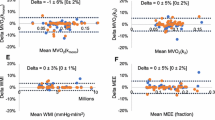Abstract
Background
Measuring the rate of clearance of carbon-11 labelled acetate from myocardium using positron emission tomography (PET) is an accepted technique for noninvasively assessing myocardial oxygen consumption. Initial myocardial uptake of [11C]acetate, however, is related to myocardial blood flow (MBF) and several tracer kinetic models for quantifying MBF using [11C]acetate have been proposed. The objective of this study was to assess these models.
Methods
Eighteen healthy subjects and 18 patients with hypertrophic cardiomyopathy (HCM) were studied under baseline conditions with [11C]acetate and [15O]water. Four previously reported methods, including single- and multi-tissue compartment models, were used to calculate MBF from the measured [11C]acetate rate of influx K 1 and the (previously) reported relationship between K 1 and MBF. These MBF values were then compared with those derived from corresponding [15O]water studies.
Results
For all models, correlations between [11C]acetate and [15O]water-derived MBF ranged from .67 to .86 (all P < .005) in the control group and from .73 to .85 (all P < .001) in the HCM group. Two out of four models systematically underestimated perfusion with [11C]acetate, whilst the third model resulted in an overestimation. The fourth model, based on a simple single tissue compartment model with spillover, partial volume and recirculating metabolite corrections, resulted in a regression equation with a slope of near unity and an Y-intercept of almost zero (controls, K 1 = .74[MBF] + .09, r = .86, SEE = .13, P < .001 and HCM, K 1 = .89[MBF] + .03, r = .85, SEE = .12, P < .001).
Conclusion
[11C]acetate enables quantification of MBF in fairly good agreement with actual MBF in both healthy individuals and patients with HCM. A single tissue compartment model with standardized correction for recirculating metabolites and with corrections for partial volume and spillover provided the best results.






Similar content being viewed by others
References
Armbrecht JJ, Buxton DB, Brunken RC, Phelps ME, Schelbert HR. Regional myocardial oxygen consumption determined noninvasively in humans with [1-11C]acetate and dynamic positron tomography. Circulation 1989;80:863-72.
Klein LJ, Visser FC, Knaapen P, et al. Carbon-11 acetate as a tracer of myocardial oxygen consumption. Eur J Nucl Med 2001;28:651-68.
Knaapen P, Germans T, Knuuti J, et al. Myocardial energetics and efficiency: Current status of the noninvasive approach. Circulation 2007;115:918-27.
Buxton DB, Nienaber CA, Luxen A, et al. Noninvasive quantitation of regional myocardial oxygen consumption in vivo with [1-11C]acetate and dynamic positron emission tomography. Circulation 1989;79:134-42.
Brown MA, Myears DW, Bergmann SR. Validity of estimates of myocardial oxidative metabolism with carbon-11 acetate and positron emission tomography despite altered patterns of substrate utilization. J Nucl Med 1989;30:187-93.
Gropler RJ, Siegel BA, Geltman EM. Myocardial uptake of carbon-11-acetate as an indirect estimate of regional myocardial blood flow. J Nucl Med 1991;32:245-51.
Herrero P, Kim J, Sharp TL, et al. Assessment of myocardial blood flow using 15O-water and 1-11C-acetate in rats with small-animal PET. J Nucl Med 2006;47:477-85.
Sun KT, Yeatman LA, Buxton DB, et al. Simultaneous measurement of myocardial oxygen consumption and blood flow using [1-carbon-11]acetate. J Nucl Med 1998;39:272-80.
van den Hoff J, Burchert W, Borner AR, et al. [1-(11)C]Acetate as a quantitative perfusion tracer in myocardial PET. J Nucl Med 2001;42:1174-82.
Chan SY, Brunken RC, Phelps ME, Schelbert HR. Use of the metabolic tracer carbon-11-acetate for evaluation of regional myocardial perfusion. J Nucl Med 1991;32:665-72.
Sciacca RR, Akinboboye O, Chou RL, Epstein S, Bergmann SR. Measurement of myocardial blood flow with PET using 1-11C-acetate. J Nucl Med 2001;42:63-70.
Porenta G, Cherry S, Czernin J, et al. Noninvasive determination of myocardial blood flow, oxygen consumption and efficiency in normal humans by carbon-11 acetate positron emission tomography imaging. Eur J Nucl Med 1999;26:1465-74.
Knaapen P, Germans T, Camici PG, et al. Determinants of coronary microvascular dysfunction in symptomatic hypertrophic cardiomyopathy. Am J Physiol Heart Circ Physiol 2008;294:H986-93.
Knaapen P, Boellaard R, Gotte MJ, et al. Perfusable tissue index as a potential marker of fibrosis in patients with idiopathic dilated cardiomyopathy. J Nucl Med 2004;45:1299-304.
Iida H, Kanno I, Takahashi A, et al. Measurement of absolute myocardial blood flow with H215O and dynamic positron-emission tomography. Strategy for quantification in relation to the partial-volume effect. Circulation 1988;78:104-15.
Hermansen F, Rosen SD, Fath-Ordoubadi F, et al. Measurement of myocardial blood flow with oxygen-15 labelled water: Comparison of different administration protocols. Eur J Nucl Med 1998;25:751-9.
Buck A, Wolpers HG, Hutchins GD, et al. Effect of carbon-11-acetate recirculation on estimates of myocardial oxygen consumption by PET. J Nucl Med 1991;32:1950-7.
Bland JM, Altman DG. Statistical methods for assessing agreement between two methods of clinical measurement. Lancet 1986;1:307-10.
Armbrecht JJ, Buxton DB, Schelbert HR. Validation of [1-11C]acetate as a tracer for noninvasive assessment of oxidative metabolism with positron emission tomography in normal, ischemic, postischemic, and hyperemic canine myocardium. Circulation 1990;81:1594-605.
El Fakhri G, Kardan A, Sitek A, Dorbala S, Abi-Hatem N, Lahoud Y, et al. Reproducibility and accuracy of quantitative myocardial blood flow assessment with 82Rb PET: Comparison with 13N-ammonia. J Nucl Med 2009;50:1062-71.
Cannon RO III, Rosing DR, Maron BJ, et al. Myocardial ischemia in patients with hypertrophic cardiomyopathy: Contribution of inadequate vasodilator reserve and elevated left ventricular filling pressures. Circulation 1985;71:234-43.
Author information
Authors and Affiliations
Corresponding author
Rights and permissions
About this article
Cite this article
Timmer, S.A.J., Lubberink, M., Germans, T. et al. Potential of [11C]acetate for measuring myocardial blood flow: Studies in normal subjects and patients with hypertrophic cardiomyopathy. J. Nucl. Cardiol. 17, 264–275 (2010). https://doi.org/10.1007/s12350-009-9181-y
Received:
Accepted:
Published:
Issue Date:
DOI: https://doi.org/10.1007/s12350-009-9181-y




